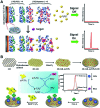Graphitic-phase carbon nitride-based electrochemiluminescence sensing analyses: recent advances and perspectives
- PMID: 35540965
- PMCID: PMC9080761
- DOI: 10.1039/c8ra02221f
Graphitic-phase carbon nitride-based electrochemiluminescence sensing analyses: recent advances and perspectives
Abstract
Graphitic-phase carbon nitride (g-C3N4) materials are important polymeric and metal-free semiconductors, and have attracted extensive attention as emerging electrochemiluminescence (ECL) emitters due to their wonderful optical and electronic properties. The g-C3N4-based ECL sensing analysis, as a research hotspot in analytical chemistry, offers an exquisite pathway to monitor target analytes with the advantages of low background signal, high sensitivity, desirable controllability, and simple instrumentation. Herein, we briefly describe the current research status of g-C3N4-based ECL assays along with versatile signaling strategies, introduce the preparation methods and ECL emission mechanisms of g-C3N4-dependent emitters, summarize their ECL sensing applications from 2012 to now, highlighting with special examples of metal ion and small molecule detection, nucleic acid bioanalysis, immunoassay, protein sensing, and cell-related determination. Finally, the prospects and challenges for future work are also explored to design more advanced ECL biosensors.
This journal is © The Royal Society of Chemistry.
Conflict of interest statement
There are no conflicts to declare.
Figures


















Similar articles
-
TiO2 nanoparticles modified graphitic carbon nitride with potential-resolved multicolor electrochemiluminescence and application for sensitive sensing of rutin.Anal Bioanal Chem. 2023 Jan;415(2):221-233. doi: 10.1007/s00216-022-04406-8. Epub 2022 Nov 3. Anal Bioanal Chem. 2023. PMID: 36326858
-
Unmasking the Electrochemiluminescence Properties of Ternary Mn/Fe/Co Metals Doped Porous g-C3N4 Fiber-like Nanostructure.Langmuir. 2024 Feb 13;40(6):3260-3267. doi: 10.1021/acs.langmuir.3c03885. Epub 2024 Jan 30. Langmuir. 2024. PMID: 38290524
-
In situ growth of L012-reduced gold nanoparticles-loaded graphitic carbon nitride nanocomposite for potential-resolved ratiometric electrochemiluminescence analysis.Anal Chim Acta. 2024 Dec 15;1332:343379. doi: 10.1016/j.aca.2024.343379. Epub 2024 Oct 29. Anal Chim Acta. 2024. PMID: 39580182
-
Innovation of Ratiometric Sensing Strategies Based on Graphitic Carbon Nitride.Crit Rev Anal Chem. 2025 Apr 11:1-25. doi: 10.1080/10408347.2025.2486213. Online ahead of print. Crit Rev Anal Chem. 2025. PMID: 40215094 Review.
-
Engineering graphitic carbon nitride for next-generation photodetectors: a mini review.RSC Adv. 2023 Sep 1;13(37):25968-25977. doi: 10.1039/d3ra04051h. eCollection 2023 Aug 29. RSC Adv. 2023. PMID: 37664204 Free PMC article. Review.
Cited by
-
Recent Progress in Plasmonic based Electrochemiluminescence Biosensors: A Review.Biosensors (Basel). 2023 Jan 29;13(2):200. doi: 10.3390/bios13020200. Biosensors (Basel). 2023. PMID: 36831966 Free PMC article. Review.
-
Ratiometric electrochemiluminescence sensing and intracellular imaging of ClO- via resonance energy transfer.Anal Bioanal Chem. 2024 Sep;416(21):4691-4703. doi: 10.1007/s00216-024-05236-6. Epub 2024 Mar 21. Anal Bioanal Chem. 2024. PMID: 38512384
-
Merging microfluidics with luminescence immunoassays for urgent point-of-care diagnostics of COVID-19.Trends Analyt Chem. 2022 Dec;157:116814. doi: 10.1016/j.trac.2022.116814. Epub 2022 Nov 7. Trends Analyt Chem. 2022. PMID: 36373139 Free PMC article. Review.
-
Electrochemiluminescence of titanium dioxide nanomaterials for sensing applications.Anal Sci. 2025 Jun 25. doi: 10.1007/s44211-025-00808-7. Online ahead of print. Anal Sci. 2025. PMID: 40560513 Review.
References
Publication types
LinkOut - more resources
Full Text Sources

